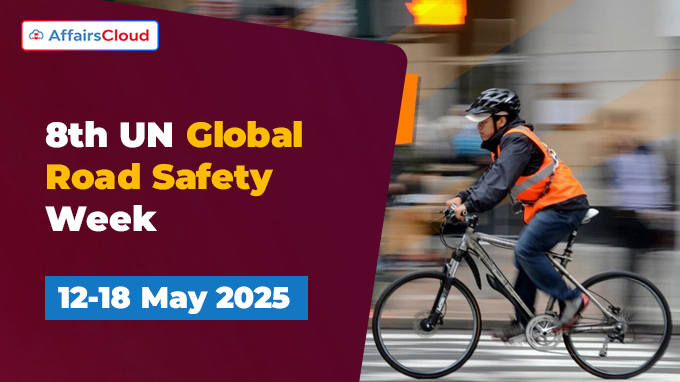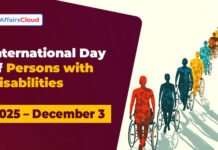 The United Nations(UN) Global Road Safety Week (UNGRSW) is a biennial campaign organized by Geneva (Switzerland) based World Health Organization (WHO) to raise awareness about road safety and advocate for measures to reduce road traffic deaths and injuries.
The United Nations(UN) Global Road Safety Week (UNGRSW) is a biennial campaign organized by Geneva (Switzerland) based World Health Organization (WHO) to raise awareness about road safety and advocate for measures to reduce road traffic deaths and injuries.
- The 8th UNGRSW is being observed from May 12 to 18, 2025.
- The 7th UNGRSW was observed from May 15–21, 2023.
Theme:
i.The theme of UNGRSW 2025 is #MakeWalkingSafe and #MakeCyclingSafe, which highlights the need for safer infrastructure and policies that protect pedestrians and cyclists.
ii.The 2025 campaign aims to mobilize communities, civil society organizations, and policymakers to take action for making urban streets safer for pedestrians and cyclists. It supports measures that help shift to healthier, sustainable, and equitable modes of transport.
Background:
i.In 2005, the United Nations General Assembly(UNGA) adopted Resolution 60/5, which mandated the World Health Organization (WHO) and the UN Regional Commissions to organize periodic road safety weeks.
ii.The first UN Global Road Safety Week was held from April 23 to 29, 2007.
- The week has been observed every two years once since 2013.
Key Interventions:
The campaign emphasizes the following evidence-based measures:
i.Safe road infrastructure: Dedicated lanes for walking and cycling, sidewalks, pedestrian crosswalks, and adequate lighting.
ii. Safe vehicles: Use of emergency braking systems, pedestrian/cyclist detection systems, and crash-protective design.
iii. Safe speeds: Urban speed limits set to 30 km/h (20 mph) with strict enforcement.
iv. Safe driving behaviour: Avoiding speeding, driving under the influence of alcohol or drugs, and distractions, supported by strong legal frameworks.
v. Emergency care: Timely and life-saving medical response systems.
Global Plan for the Decade of Action for Road Safety 2021–2030:
i.Walking and cycling are integral components of the Global Plan for the Decade of Action for Road Safety 2021–2030, which emphasizes the development of multimodal transport systems that are safe, inclusive, and sustainable.
- The plan advocates for road infrastructure that supports various modes of transportation, including walking, cycling, and public transit, to enhance safety and accessibility for all road users, especially the most vulnerable.
ii.This approach aligns with the Stockholm Declaration, promoting policies that encourage walking, cycling, and public transport as inherently healthy and environmentally sound modes of transport.
iii.By integrating walking and cycling into transport planning, the Global Plan aims to reduce road traffic deaths and injuries by 50% by 2030, contributing to the achievement of the Sustainable Development Goals (SDGs).
Key facts:
i.According to the WHO, Road traffic injuries remain one of the most significant public health challenges globally, claiming the lives of nearly 1.2 million people and injuring up to 50 million others each year.
ii.According to the World Health Organization’s Global Status Report on Road Safety (GSRRS) 2023, pedestrians and cyclists account for more than one in four road traffic deaths globally. The African region faces a particularly severe impact, contributing to nearly a quarter of all global road fatalities.
About World Health Organization (WHO):
Director-General(DG) – Dr. Tedros Adhanom Ghebreyesus
Headquarters – Geneva, Switzerland
Established– 1948




